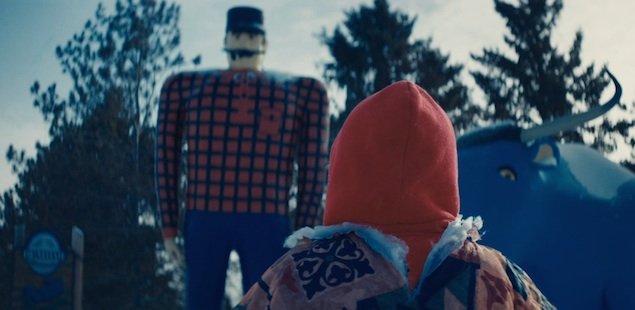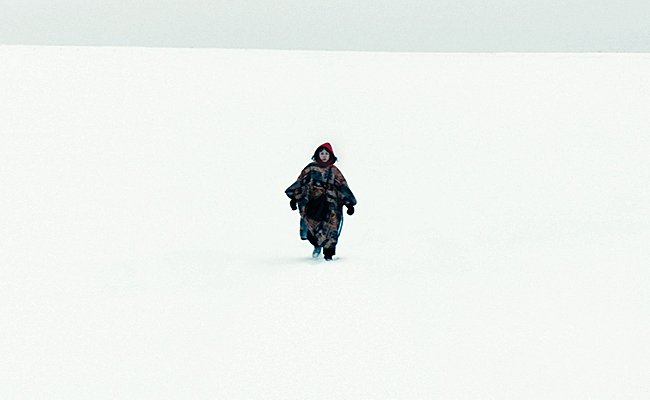Kumiko The Treasure Hunter – A Film To Be Enlightened by… Eventually
Alternative Title: The Zellner Brothers Called Me Up at Two in the Morning And Hung Up The Phone Without Ever Telling Me Why: a review of Kumiko, The Treasure Hunter
A Nightmarish Flâneur
Kumiko, The Treasure Hunter has been marketed as a drama and fantasy. Clearly, the element of creating one’s own meaning and then living out this abstract activity is regarded as having a characteristic of the magical, the fantastical. Yet, the movie’s shots do everything to deny the magical, the fantastic. In the first half of the movie Kumiko works as one of many secretaries to a boss who regards her as too old and too ugly for a job that is traditionally viewed as a stepping-stone to marriage for young women. The lighting is plain, the music is plain. (Imagine living in a K-Mart bathroom.) It’s not hard to understand why Kumiko seems so bored, so exhausted by, well, everything.
Juxtaposed to this are camera shots that follow her like a voyeur, rarely allowing her the center of the scene. She’s always on the margin. Just barely in the shot. I couldn’t help feeling as if it was Kumiko watching herself, unable to have even the most basic notion of self-awareness, self-communication. Nothing that she can identify as “this is something inside me that says that it is me, that belongs to me”. Nothing appears to belong to her. Because of this, there is an inability to enter into the world around her. It rushes around her and she watches it helplessly.
In a way, she’s a nightmarish realization of Baudelaire’s and Benjamin’s ideas of the flâneur.
The flâneur, as Charles Baudelaire saw it, was a “passionate spectator” who takes “immense joy” in being “away from home and yet [feeling] oneself everywhere at home; to see the world, to be at the center of the world” who remains hidden from the world. There’s no particular motive in looking, just looking, being absorbed into one’s own gaze. Benjamin said that advertising had heightened the motives of spectating. We were all consumers looking to buy, not spectators wishing to see. The flâneur, according to Walter Benjamin, had been reduced to the “sandwich board man”, the person whose being has been transformed into an advertisement and is, therefore, part of the scenery.
Kumiko has a more insidious relationship to this concept.
She becomes her own flâneur, lodged outside herself, watching herself dispassionately. She is both object and elusive subject. When she is noticed (for example, by own school friend her invites her to dinner), when she is objectified, she flees. When her boss asks her directly if she likes her job, she quietly acknowledges that she does (a dismissive gesture done as she sinks lower and lower in her seat in an attempt to make herself invisible).
The only time that Kumiko the subject and Kumiko the object reach some sort of Hegelian fusion is through studying the movie Fargo. The movie becomes the über-object, the sublime object. Unlike the outside world with which she finds no hope, no path, no access point, the movies becomes a medium through which she realizes a holistic selfhood. And within this selfhood comes the intuitive moment, the freedom to interpret from unrelated imagery a direction relation to herself. The film receives not just an interpretation but clues to a divine door, an access point into the divine.
Affective Fallacy
This may be a bit too abstract but I want to assure you that it has some species of validity. I empathized with Kumiko because I had my own Fargo, my own moment of divine meaning with the Korean movie, Christmas in August . I’d seen this movie as a young teacher in Korea with another teacher, a Korean woman with whom I’d fallen in love. I always confessed to this movie being my favorite and she sent me a copy for Christmas several years after I’d left the country. I studied this movie intensely. I don’t know how many times I’ve seen it. The movie itself follows the owner of a photography business suffering from an unnamed terminal illness who falls in love with a meter maid. They spend a lot of time together (much like I did with the Korean teacher), they seem to be somewhat fond of each other (much like I imagined the Korean teacher and I were) and they are suddenly separated from each other forever (I could swing this, too…although I just left the country whereas he actually died).
I thought that this movie was sending me an important message. The Korean teacher had been sending me an important message, too: it’s not too late, Nick.
Now that the fog of youthful infatuation has faded, I’m aware that I was experiencing what new critics call “the affective fallacy”, wherein works of poetry were interpreted not by the objective aesthetic truth of the piece; rather, they were judged masterpieces by their emotional affect upon the reader (there are problems with a stalwart adherence to this approach but that’s for another time).
Looking at Kumiko’s actions with the glaze of a new critic, I can say that she’s “read too much into the movie” or (in critical argot) she has committed “an affective fallacy”. I’ll hold true to this to a certain extent. It works fine as long as she stays in Japan. But Kumiko travels to Minneapolis to seek out a treasure using only a map of Minnesota that she tore out of a library book and a hand-sewn map based on a tracing of a scene from the movie (the scene is of Steve Buschemi burying a suitcase full of money). The further Kumiko goes into America, the more the artifice of her mythos surrounded the treasure falls apart. Much of the strength of her fantasy comes from the intimate experience of holistic selfhood that her study of Fargo allows. In a society that gives her no direction, she can retreat to an interior reality that assures her that she finds no meaning in Japan because she has meaning elsewhere.
It’s a religious thought. What I can’t have here, I’ll get in heaven.
Picaresque, Ouroboros and Enlightenment
The delusional fantasy (based in my affective interpretation of Christmas in August) was only shed after numerous (highly expensive) trips back to South Korea. Finally, the realization hit me: I had formed reality to fit within the framework of a contained artistic structure. Things have a beginning, middle and end. And they have a meaning. And the meaning is the interpretation that I have reached after years of studying a contained sphere of set images. The truth being drawn from a source that itself was only the result of an interpretation influenced by repressed emotions.
An ouroboros endlessly eating itself.
It’s a spiral that Kumiko becomes lost in near the end of the movie. She wanders without direction through the Minnesota woods in mid-winter. The spiral, the loose trajectory of a character is something the Zellner Brothers favor. Previous films Goliath (a 2008 movie named after the main character’s cat that goes missing right around the time his life is falling apart) and Kid-Thing (a 2012 film following the exploits of Annie whose lack of parental supervision results in a complete lack of moral compass and perhaps aides the death of a young woman trapped in a well) are picaresque narratives that allow characters no goal or no desire for a goal. Kumiko falls in-between these two: she has a goal but no one will recognize it. She wants to be transported out of the invisibility of the flâneur, but despite the seemingly endless pathways available to her (alleyways and side streets in Japan, highways and open country in Minnesota) pathways are, ironically, just pathways. They don’t lead anywhere.
The movie left me unsettled. Is Kumiko being aggrandized for following her dream despite it being a dangerous delusion? Is she a hero because she will die for her ideals rather than conform to the model society imposes upon her?
Or, is she just being childish? Is she refusing to deal with reality? Is she refusing to grow up and sift through her interior life, ask herself why she is feeling this way and she does the things she does? Why she obsessively studies a single scene from an American black comedy?
The final scene, of course, justifies her fantasy. The previous scene was obviously her final one. She’s dead, of course! But wait. Nope! She’s alive. Sigh. Superficially, it seemed like a cop-out. I thought, here we have this Japanese crazy woman about to act out “To Build A Fire” by Jack London and suddenly we get a scene cut from Big Fish.
But it’s been a week since I saw the movie. And I get it now.
This scene wasn’t Zellner giving up. It was Zellner pulling something from the old sardonic American zen movement. The movie’s question was this:
What happens if Kumiko follows her dreams?
She gets them of course.
The answer doesn’t not satisfy and you better just deal with it. Enjoy enlightenment, motherfucker.




